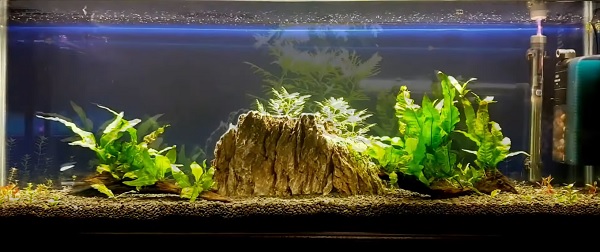How To Easily Clean Aquarium Substrate with or without using Siphon Vacuum Gravel Cleaner?
If your aquarium gravels are
dirty then it would pollute your aquarium water & it is dangerous for your
fish. When you overfeed your fish then the leftover food stuck in the gravel
which releases harmful chemicals. If you have rotting live plants in the
aquarium, then it would make the substrate dirty. Also fish waste is trapped in
the gravel which pollutes the water.
If you do regular water changes
then it would remove the harmful chemicals that are released from matter such
as rotten plant, fish waste & leftover food, but if your gravels are dirty
then it would pollute the fresh water quickly. Hence, it is very important to
clean the aquarium substrate to remove the leftover matter that is polluting
your water, & also you can clean your tank glass surfaces & decorations.
My recommendation is to vacuum
your tank gravel while doing regular water changes to clean your substrate.
In this article we are going to
see various methods of cleaning tank gravel using or without using a vacuum
cleaner.
If your aquarium is cycled, then
you will have a balanced amount of good bacteria that can breakdown harmful
ammonia that releases from fish waste into less harmful nitrites & further
breakdown nitrites into nitrates which is even less harmful & can be
removed with regular water changes. This process is done very fast when your
aquarium is cycled & also people use biological filtration media in their
filter to house large quantity of beneficial bacteria. Often people think that
mechanical filtration is important because it traps fish waste but the best
filtration is biological filtration. Mechanical filtration traps fish waste but
allows ammonia that releases from fish waste to pass through the mechanical
filtration media. Biological filtration media consists of porous material that
has numerous tiny pores that houses lots of good bacteria which breaks down
ammonia into nitrites & further into nitrates. Usually normal filter can’t
remove nitrates from the aquarium & we use live plants which absorb
nutrients & they help plants in growth.
You must use vacuum cleaner to
suck food particles & rotten plants matter from your gravels. If you fail
to clean your substrate, then it could challenge you to do more regular water
changes. Dirty water will grow algae too.
How often you must clean tank
substrate is based on the dynamics of your aquarium. Dirt builds up quickly in
smaller aquariums that do not have plants & have too many fish. Also you
must do complete substrate cleaning after every 2 weeks.
It is very important to change 10
to 20 percent water weekly.
Having a thickly planted aquarium,
will only require regular gravel cleaning once in a month. It is very important
to make sure that dead plant leaves that decompose on substrate do not toxic
your tank water.
Tanks having too many fish will have more dirt on the gravels. For clear water you need to wash your gravels once in two weeks. If your tank water is clear, then you can vacuum gravel your substrate once in a month.
How to clean fish tank substrate:
There are multiple methods for
cleaning your tank substrate. You can choose any method by considering the
situation, type & how much dirt is accumulated on your gravel.
How to wash your gravel with a vacuum kit:
You can vacuum fish tank gravel using
a siphon vacuum gravel cleaner. It follows the principle of gravity & hydrostatic
pressure to vacuum dirt from gravels & assist in taking it out of the
aquarium.
Make sure your siphon tube is
always higher than the fish tank being cleaned to take out the dirt while
avoiding the gravity which stops water going out.
Dirty water should fill up a
bucket placed outside aquarium.
Make sure air bubbles should not
form in the vacuum tube or your siphon vacuum kit will not work well.
Make sure the tube is filled with
the dirt before you take it out of the aquarium.
Steps:
Step 1: Turn off electrical appliances:
Unplug your aquarium heater,
aquarium filter & air pump before you start cleaning your aquarium. Do not
disturb your tank & allow your fish to stay in the water & do not
remove decorations or plants. This method is usually fast & should not
stress your fish that much.
Step 2: Submerge:
Use your substrate cleaning kit
& bucket. Place your tank bucket below tank level & start the cleaning process
by submerging the kit in your aquarium. Place the vacuum tube fully inside
water.
Step 3: Up & down Motion:
Start moving the tube in the
water in small up & down motions of about 2 to 4 inches around substrate
until water starts its motion of coming out of the aquarium using the tube.
Step 4: Vacuuming:
Once dirty water starts coming
out of aquarium, move the tube over the complete substrate to ensure you remove
all of the dirt.
Make sure you thoroughly remove
dirt from complete aquarium gravels. The tube might remove some of the pebbles,
but they will fall back in the aquarium after you raise the tube.
Step 5: Remove the Tube:
After your tank has 75 % water
left, just remove the tube.
Step 6: Turn on electrical appliances:
After thorough cleaning of the
substrate, turn on your heater, filter & air pump.
Cleaning of aquarium gravel without using a vacuum kit:
It is difficult to clean your
aquarium substrate without using a vacuum gravel. This process will need lots
of time & effort.
Also it is not a good way of
cleaning because it can stress your fish & disturb your aquarium balance.
It involves removing your aquarium
fish & setting a separate aquarium for them, & taking out the substrate
from the aquarium. It is a stressful process for the fish & will imbalance
bacteria colonies.
In this method, you will be able
to break compact substrate pockets that cover tough organic dirt.
In order to remove dirt without
using a vacuum, you can follow steps mentioned below:
Steps:
Step 1: Setup New Aquarium:
Setup a clean aquarium where you
can temporarily shift your fish while you are busy in cleaning substrate. Move
about 50 % aquarium water to the new aquarium.
This way your fish will have the
same water conditions & will not be stressed that much.
Step 2: Shift your fish to the new aquarium:
Use a fish net to shift your fish
to the new aquarium.
Step 3: Turn off electrical appliances:
Turn off your heater, filter
& air pump.
Step 4: Clean your substrate:
Remove decorations & live
plants. Take the dirty substrate out of the aquarium & place it in a clean container.
Wash your gravels with water.
Do not clean all the gravels
because this way you will lose all of your good bacteria. Make sure you leave middle
& bottom layer of gravel & only remove top layer or if gravels are very
dirty then clean middle layer of gravels too.
Step 5: Turn on aquarium appliances:
Spread clean gravel in aquarium,
& add decorations & live plants. It is time to turn on heater, filter
& air pump.
Step 6: Add Clean Water:
Add clean water & make sure
it has the right temperature & pH.
Step 7: Add Fish:
Transfer fish back from new aquarium
to the main aquarium using fish net.


Post a Comment